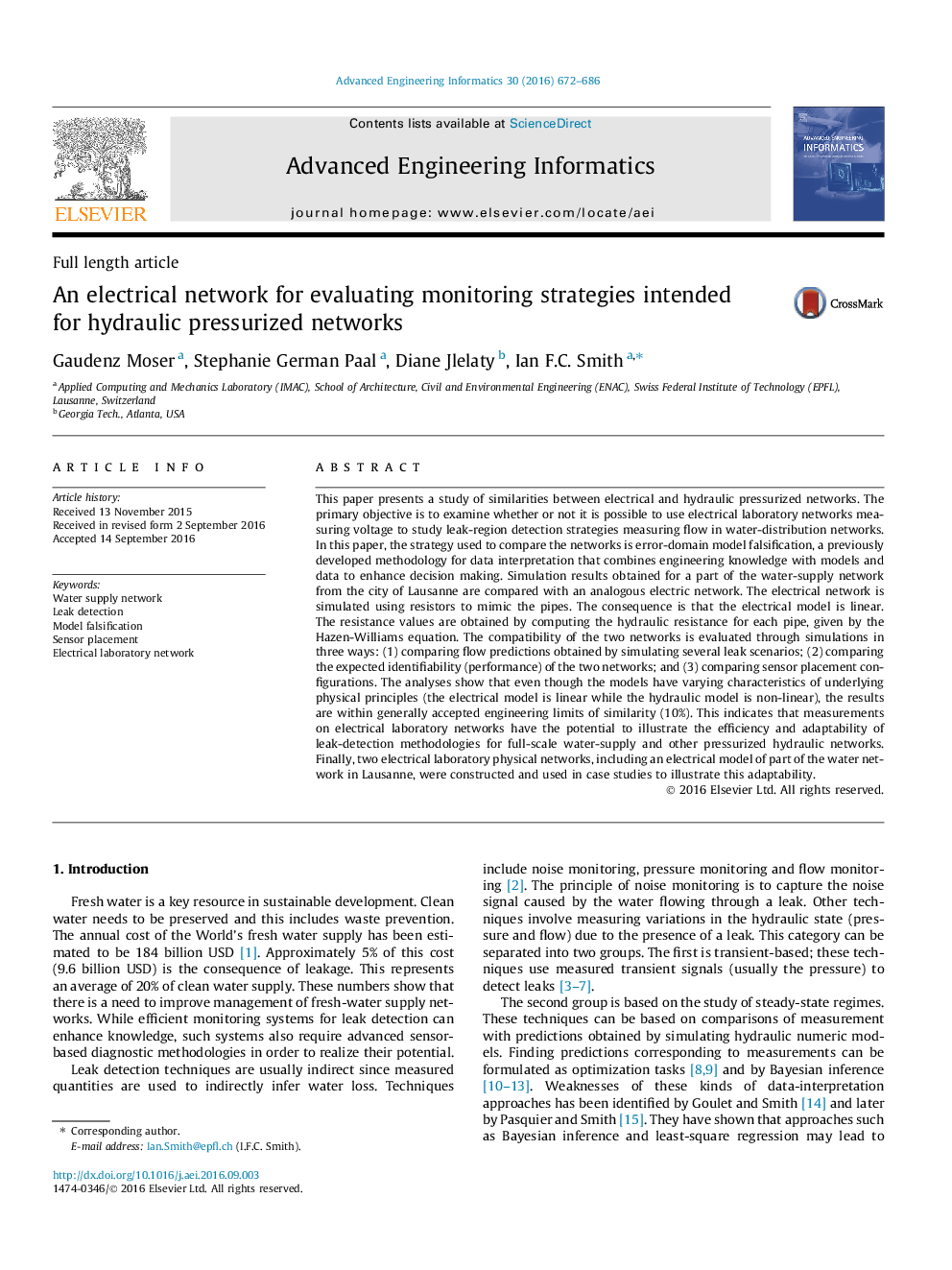| کد مقاله | کد نشریه | سال انتشار | مقاله انگلیسی | نسخه تمام متن |
|---|---|---|---|---|
| 6679625 | 501787 | 2016 | 15 صفحه PDF | دانلود رایگان |
عنوان انگلیسی مقاله ISI
An electrical network for evaluating monitoring strategies intended for hydraulic pressurized networks
ترجمه فارسی عنوان
یک شبکه برق برای ارزیابی استراتژی های نظارت برای شبکه های فشار هیدرولیکی
دانلود مقاله + سفارش ترجمه
دانلود مقاله ISI انگلیسی
رایگان برای ایرانیان
کلمات کلیدی
شبکه تامین آب، تشخیص نشت، جعل مدل، قرار دادن سنسور، شبکه آزمایشگاه برق
ترجمه چکیده
در این مقاله، مطالعه شبیه سازی شبکه های تحت فشار هیدرولیکی و هیدرولیکی بررسی شده است. هدف اولیه بررسی این است که آیا می توان از شبکه های آزمایشی الکتریکی اندازه گیری ولتاژ برای مطالعه راهبرد های تشخیص نشتی در جریان شبکه های توزیع آب استفاده کرد. در این مقاله، استراتژی مورد استفاده برای مقایسه شبکه ها، جعل مدل خطای دامنه، یک روش پیشنهادی برای تفسیر داده است که دانش مهندسی را با مدل ها و داده ها ترکیب می کند تا تصمیم گیری را افزایش دهد. نتایج شبیه سازی به دست آمده برای بخشی از شبکه تامین آب از شهر لوزان با یک شبکه الکتریکی مشابه مقایسه شده است. شبکه برق با استفاده از مقاومت به منظور تقلید لوله ها شبیه سازی شده است. نتیجه این است که مدل الکتریکی خطی است. مقادیر مقاومت توسط محاسبه مقاومت هیدرولیکی برای هر لوله بدست آمده توسط معادله هزن-ویلیامز بدست می آید. سازگاری این دو شبکه از طریق شبیه سازی به سه روش ارزیابی می شود: (1) مقایسه پیش بینی های جریان داده شده توسط شبیه سازی چندین سناریو نشت؛ (2) مقایسه شناسایی (عملکرد) مورد انتظار از دو شبکه؛ و (3) مقایسه پیکربندی موقعیت های حسگر. تجزیه و تحلیل ها نشان می دهد که هرچند مدل ها ویژگی های متفاوتی از اصول فیزیکی پایه دارند (مدل الکتریکی خطی است در حالی که مدل هیدرولیکی غیر خطی است)، نتایج در حد قابل قبول مهندسی محدودیت شباهت (10٪) است. این نشان می دهد که اندازه گیری ها در شبکه های آزمایشگاهی الکتریکی بالقوه برای نشان دادن کارایی و سازگاری روش های شناسایی نشت برای تامین آب کامل در مقیاس و دیگر شبکه های هیدرولیکی تحت فشار است. سرانجام، دو شبکه فیزیکی الکتریکی آزمایشگاهی، از جمله یک مدل الکتریکی بخشی از شبکه آب در لوزان، در مطالعات موردی برای نشان دادن این سازگاری طراحی و ساخته شدند.
موضوعات مرتبط
مهندسی و علوم پایه
مهندسی کامپیوتر
هوش مصنوعی
چکیده انگلیسی
This paper presents a study of similarities between electrical and hydraulic pressurized networks. The primary objective is to examine whether or not it is possible to use electrical laboratory networks measuring voltage to study leak-region detection strategies measuring flow in water-distribution networks. In this paper, the strategy used to compare the networks is error-domain model falsification, a previously developed methodology for data interpretation that combines engineering knowledge with models and data to enhance decision making. Simulation results obtained for a part of the water-supply network from the city of Lausanne are compared with an analogous electric network. The electrical network is simulated using resistors to mimic the pipes. The consequence is that the electrical model is linear. The resistance values are obtained by computing the hydraulic resistance for each pipe, given by the Hazen-Williams equation. The compatibility of the two networks is evaluated through simulations in three ways: (1) comparing flow predictions obtained by simulating several leak scenarios; (2) comparing the expected identifiability (performance) of the two networks; and (3) comparing sensor placement configurations. The analyses show that even though the models have varying characteristics of underlying physical principles (the electrical model is linear while the hydraulic model is non-linear), the results are within generally accepted engineering limits of similarity (10%). This indicates that measurements on electrical laboratory networks have the potential to illustrate the efficiency and adaptability of leak-detection methodologies for full-scale water-supply and other pressurized hydraulic networks. Finally, two electrical laboratory physical networks, including an electrical model of part of the water network in Lausanne, were constructed and used in case studies to illustrate this adaptability.
ناشر
Database: Elsevier - ScienceDirect (ساینس دایرکت)
Journal: Advanced Engineering Informatics - Volume 30, Issue 4, October 2016, Pages 672-686
Journal: Advanced Engineering Informatics - Volume 30, Issue 4, October 2016, Pages 672-686
نویسندگان
Gaudenz Moser, Stephanie German Paal, Diane Jlelaty, Ian F.C. Smith,
